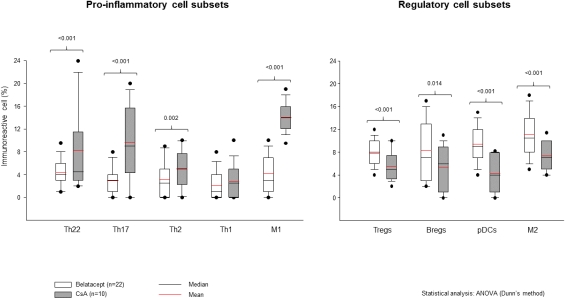Immunophenotype of Cells Infiltrating the Graft Explains the Benefits of Belatacept
J. Furuzawa-Carballeda,1 N. Uribe-Uribe,2 G. Mondragon-Ramirez,4 J. Arreola-Guerra,5 R. Reyes-Acevedo,5 M. Vilatoba,3 R. Chavez-Fernandez,1 F. Lopez-Verdugo,1 A. Lopez-Toledo,4 G. Mondragon-Salgado,4 J. Alberu.3
1Immunology, Inst. Nal. C. Medicas y Nutricion SZ, Mexico City, Mexico
2Pathology, Inst. Nal. C. Medicas y Nutricion SZ, Mexico City, Mexico
3Transplantation, Inst. Nal. C. Medicas y Nutricion SZ, Mexico City, Mexico
4Inst Mex de Trasplantes, Cuernavaca, Mexico
5Transplantation, C. Hospital Miguel Hidalgo, Aguascalientes, Mexico.
Meeting: 2018 American Transplant Congress
Abstract number: 117
Keywords: Biopsy, Graft-infiltrating lymphocytes, Immunosuppression, Kidney transplantation
Session Information
Session Name: Concurrent Session: Kidney Immunosuppression: Co-Stimulation Based Regimens
Session Type: Concurrent Session
Date: Sunday, June 3, 2018
Session Time: 4:30pm-6:00pm
 Presentation Time: 4:30pm-4:42pm
Presentation Time: 4:30pm-4:42pm
Location: Room 6C
Previously, we found greater amounts of FoxP3 cells and lower amounts of CD4+/IL-17A+ and senescent cells in belatacept (Bela) patients compared to patients under cyclosporine (CsA) treatment in 12 mo graft biopsy from patients participating in the BENEFIT study. The BENEFIT have demonstrated that seven years after kidney transplantation (KT), patient and graft survival and the mean eGFR were significantly higher with Bela than with CsA. Whether the immunophenotype of inflammatory vs regulatory cell subsets infiltrating the graft participates in BENEFIT´s clinical findings a decade after KT, constitutes the aim of this study. Patients and Methods: Thirty-two adults, functionally stable KTR, accepted and signed informed consent for graft biopsy (Bxs) performance: n=22 continue on Bela, n=7 continue on CsA, and n=3 were switched from Bela to Tacrolimus during the first 6 months post-KT. Bxs were immunostained for inflammatory and regulatory cells markers and analyzed blinded to treatment arm. Results are depicted in Figure 1. Significantly lower percentages of inflammatory cells –Th22 (CD4+/IL-22+), Th17 (CD4+/IL-17A+), Th2 (CD4+/IL-4+), and M1 macrophages (CD16+/TNF-α+)– were observed in Bela compared with CsA patients. In contrast, significantly higher percentages of regulatory cells –Tregs (CD25+/Foxp3+), Bregs (CD20+/IL-10+), pDCregs (CD123+/L-kinurenine+), and M2 macrophages (CD163+/IL-10+)– were observed in Bela compared to CsA patients. 
Conclusions: The findings strongly suggest that inmmunoregulatory mechanisms participates in the long-term graft function stability in patients on Bela treatment.
CITATION INFORMATION: Furuzawa-Carballeda J., Uribe-Uribe N., Mondragon-Ramirez G., Arreola-Guerra J., Reyes-Acevedo R., Vilatoba M., Chavez-Fernandez R., Lopez-Verdugo F., Lopez-Toledo A., Mondragon-Salgado G., Alberu J. Immunophenotype of Cells Infiltrating the Graft Explains the Benefits of Belatacept Am J Transplant. 2017;17 (suppl 3).
To cite this abstract in AMA style:
Furuzawa-Carballeda J, Uribe-Uribe N, Mondragon-Ramirez G, Arreola-Guerra J, Reyes-Acevedo R, Vilatoba M, Chavez-Fernandez R, Lopez-Verdugo F, Lopez-Toledo A, Mondragon-Salgado G, Alberu J. Immunophenotype of Cells Infiltrating the Graft Explains the Benefits of Belatacept [abstract]. https://atcmeetingabstracts.com/abstract/immunophenotype-of-cells-infiltrating-the-graft-explains-the-benefits-of-belatacept/. Accessed November 25, 2025.« Back to 2018 American Transplant Congress
